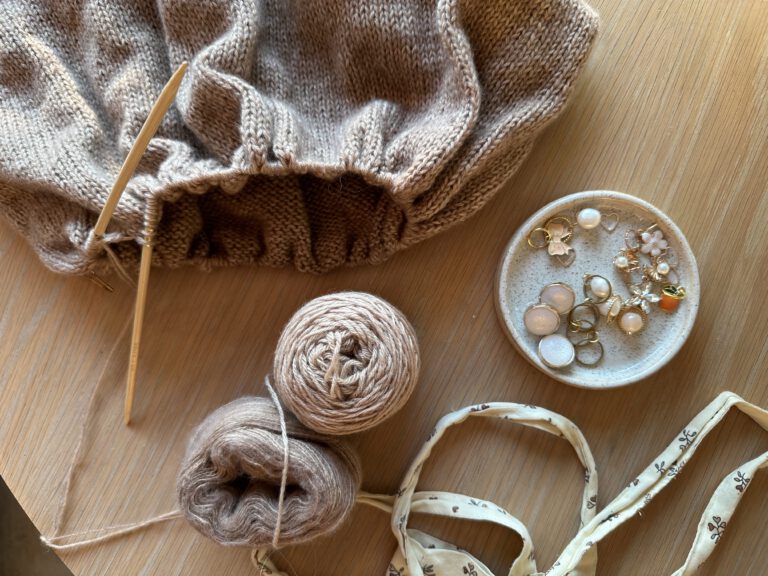A lot of us dream about chunky scarves, adorable hats, and warm blankets, especially during the winter. What could be better than making these pieces yourself? With knitting, you get an accessible hobby you can practice almost everywhere. At the same time, it’s a mindful activity that can help you relax and de-stress while producing beautiful handmade items. In other words; knitting unlocks a whole new world of creative possibilities. That said, knowing where to start as a beginner can be tricky. If we had a penny for every time we got the question “What should I knit as a beginner?” we’d be rich. Fortunately, we’re here to help you.
In this guide, we’ll walk you through 6 easy knitting projects for beginners, and provide some of our best tips and tricks when starting your first project! Keep on reading to learn everything from how to choose the right needles and yarn, as well as a list of beginner-friendly and small knitting projects that will have you knitting confidently in no time.
Check out our new webshop for everything you need in your next knitting project!
What do I need to get started?
Before diving into your first project, there are a few essential supplies you’ll need. Firstly, you need to start by choosing the perfect knitting needles and yarn. As with any crafty project, it’s a good idea to make sure you have everything you need before you begin. Let’s take a closer look at needles and yarn, and how to choose the right supplies for your beginner-project.

Beginner-friendly knitting needles
When embarking on your beginner knitting project, choosing the right needles is crucial for a smooth and enjoyable experience. As a rookie, look for needles that prioritize comfort, ease of use, and control. Here’s what to consider to find the perfect “beginner-friendly” knitting needles:
Material
Wood or bamboo needles are generally considered the best choice for beginners. They offer a warm, comfortable feel in your hands, and the slightly grippy texture helps prevent stitches from slipping off. Plastic needles can be a more affordable option, but they can feel slick and may lead to dropped stitches. Metal needles are typically used for more advanced projects or specific yarns, as they can be less forgiving for beginners due to their smooth surface.
Size
Finding the perfect needle size is the key to success with your knitting project. In general, the best needles for beginners range in US sizes 6-10 (4.5 mm – 5.0 mm). This is because smaller needles can be a bit tricky to manage, while super bulky needles might feel cumbersome, especially if you have smaller hands. A great idea is to experiment a little at your local yarn store to find the size that feels most comfortable in your grip.
Length
The length of your needles depends on the type of project you’re working on. For most beginner projects like scarves, washcloths, or headbands, shorter needles (around 8-10 inches or 20-25 cm) are easier to handle and maneuver. Circular needles, which are two needles connected by a flexible cable, are an ideal choice for projects knitted in the round, like hats or socks. For circular needles, a length of 16 inches or 40 cm is a good starting point for beginners.
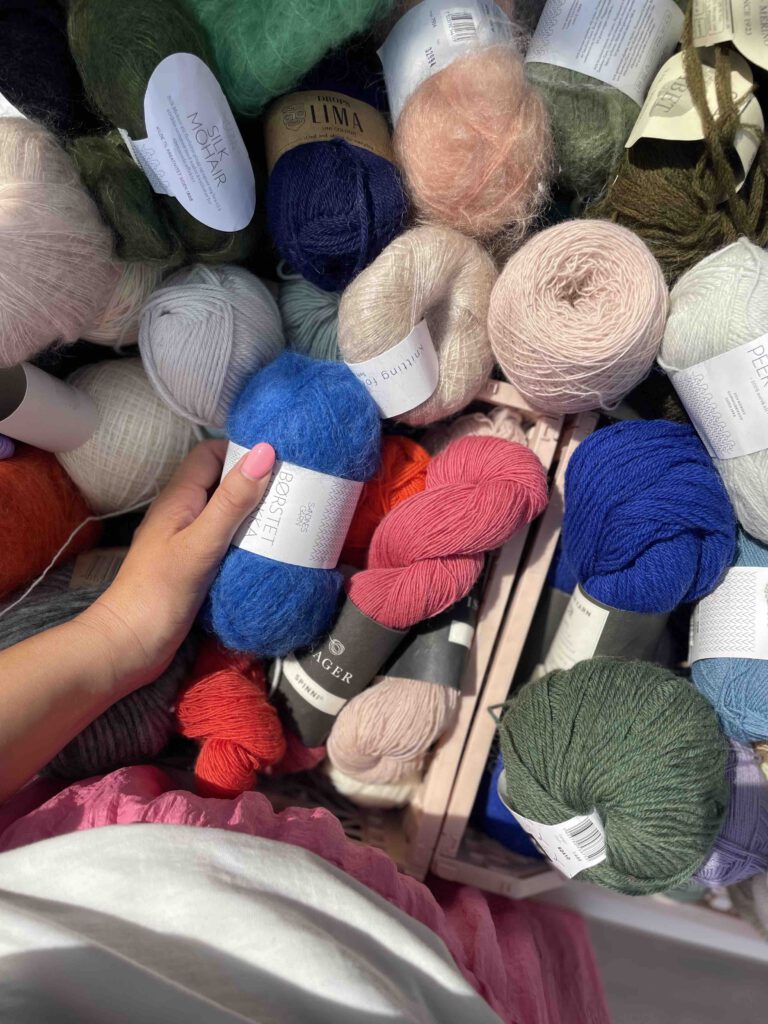
Choosing the right yarn
While roving yarns might be all the rage with their chunky appeal, they tend to pill quite easily. Additionally, they tend to carry a hefty price tag. As a beginner, here are a few things to consider when choosing a yarn for your first project:
Yarn Weight
Yarn weight refers to the thickness of the yarn. When opting for a yarn suitable for knitting projects for beginners, worsted weight yarn is a great place to start. It’s not too bulky or too thin, making it easier to see your stitches and handle the needles.
Lighter-weight yarns (like fingering weight) can be trickier to manage for new knitters, while heavier-weight yarns (like bulky) might require larger needles and can create a project that’s too stiff for some applications.
Fiber Content
The type of fiber used to create the yarn will impact its feel, care requirements, and suitability for your project. Natural fibers like wool are warm and breathable but may require handwashing. Acrylic yarn is a popular choice for beginners because it’s soft, affordable, and machine-washable. Look for a yarn blend that combines the benefits of different fibers, like wool and acrylic for warmth and washability. Cotton yarn is a good choice for projects like washcloths or tote bags as it’s absorbent and dries quickly.
Color
This is where you can get creative! For your first project, we would recommend using a solid color yarn in a light or medium shade. This will make it easier to see your stitches and identify any mistakes. Once you’re comfortable with the basics, you can explore variegated yarns with color changes or experiment with stripes or colorwork using multiple yarn colors.
Remember, the best yarn for your project is the one that you find appealing and manageable!
Mastering the basics
Along with the right supplies, you should also master the fundamental techniques of knitting. Even the easiest knitting projects for beginners acquire some solid techniques. But fear not, there are just a handful of basic knitting techniques you should be familiar with before diving into your first project. These foundational skills will allow you to tackle a wide variety of beginner-friendly patterns:
1. Casting On: This is the first step in any knitting project. It involves creating a row of stitches on your needle that will serve as the base for your knitting.
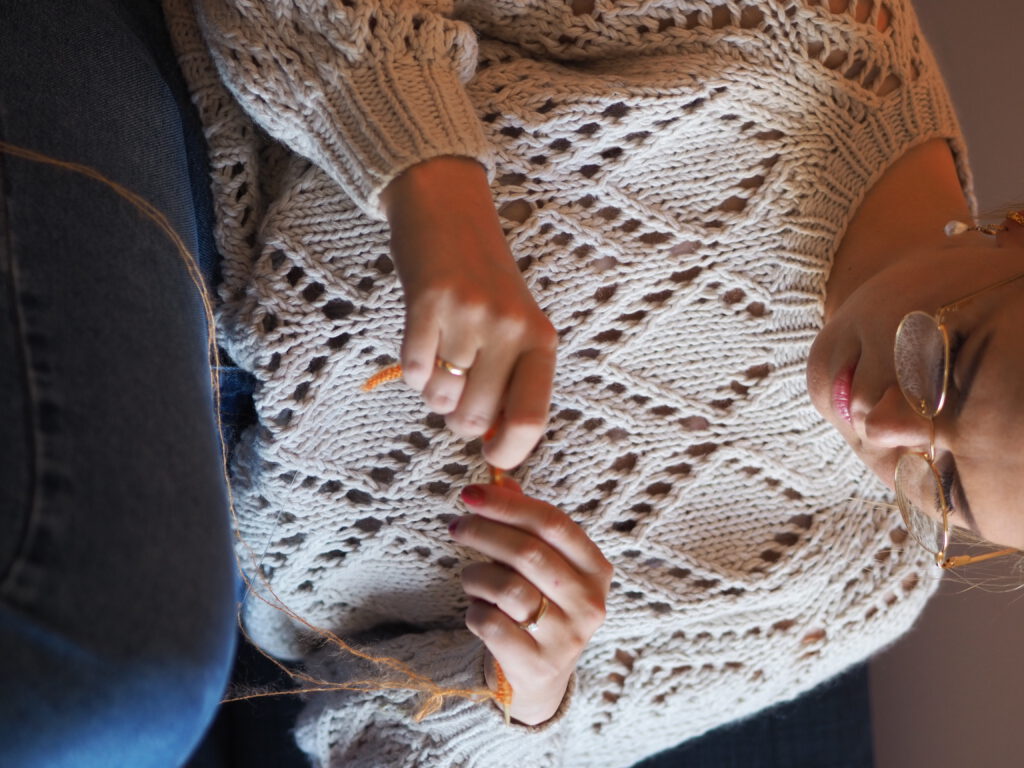
2. Knit Stitch: This is the most fundamental stitch in knitting. It’s where you insert your needle into a stitch wrap the yarn around the needle, and pull it through the old stitch, creating a new one. Our Stitch markers are a great way to start!
3. Binding Off: This technique secures the last row of stitches on your project, preventing them from unraveling.
4. Weaving in Ends: When you start and finish a project, you’ll have yarn tails left over. Weaving these ends into the body of your knitting hides them and creates a neat finish.
Head’s up! There are informative videos available in our app that neatly guides you through these techniques. It’s never been easier to take up knitting!
Picking out an easy knitting project for beginners
Now that you’re armed with the basics, it’s time to explore some fun and achievable knitting projects! We have picked out a selection of fantastic options, perfect for beginners, with varying difficulty levels. Each project will come with a clear description, a difficulty rating, and a list of materials needed. Get ready to unleash your creativity and conquer cute creations as we delve into projects like scrunchies, coasters, headbands, washcloths, tote bags, and scarves!
1. Scrunchie - Easy
A scrunchie is a great place to begin your knitting journey. Not only is it a fairly easy piece to knit, it’s also very practical. In addition, it’s a nice way to introduce some color or texture to an outfit.
Materials
- Worsted, medium weight yarn in whatever color you prefer
- Size US 8 (5.0 mm) circular knitting needles
- Sewing needle
- Tapestry needle (optional)
- Hair elastic
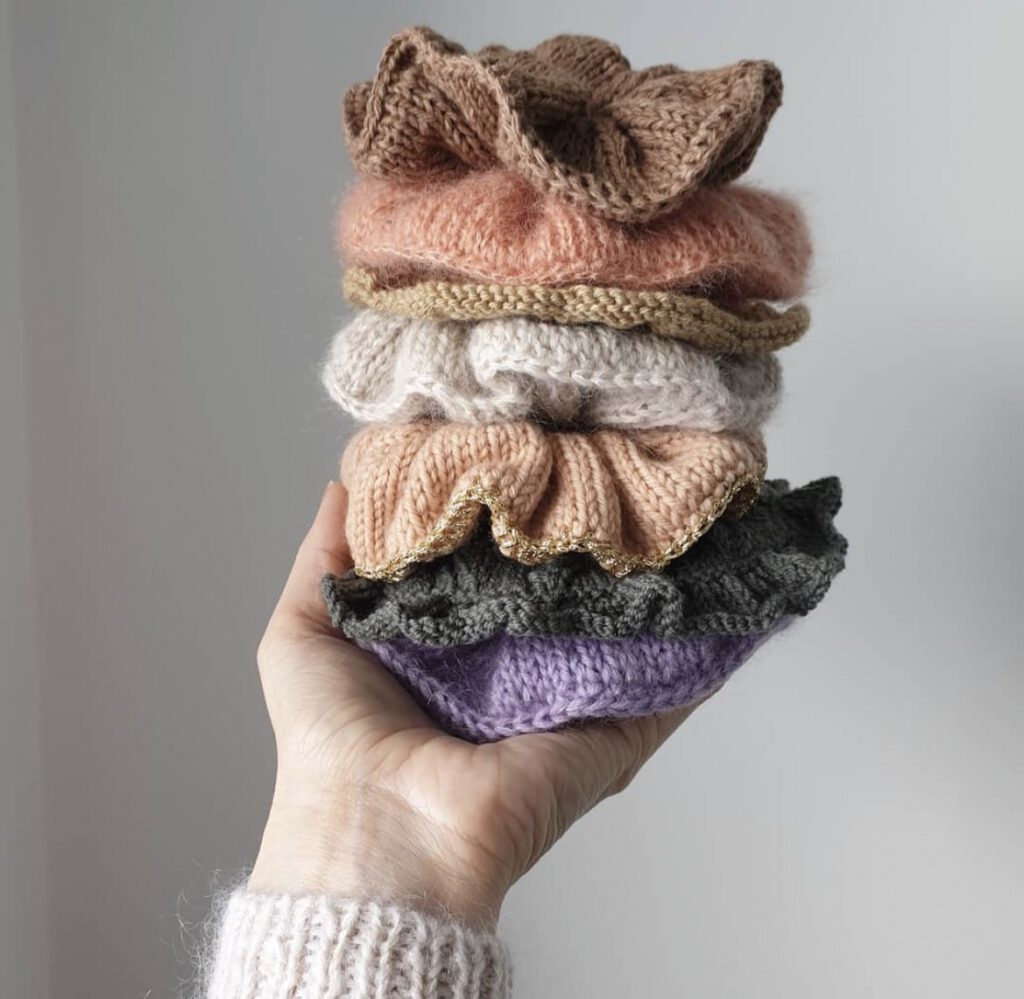
Instructions
- Cast on 40-50 stitches.
- Knit every row. This means inserting your needle into the front loop of each stitch on the row below and knitting a new stitch. We are using a method called “garter stitch” which creates the stretch necessary for a scrunchie. You want to continue until you have your desired length, for example 3-4 inches or 8-10 cm.
- Bind off in a secure way.
- Sew or weave the last bit. Start with laying the knitted piece flat and fold it in half lengthwise, and sew the two short ends together. If you want a cleaner look, you can weave the tails with a tapestry needle. However, this is optional.
- Insert the hair elastic. You need to fold in the hair elastic in the gap you left while sewing the knitted base together. Tie a knot in the elastic and hide it by sliding it down the fabric. Pull the fabric over the elastic to create a professional finish.
Tips
- How many stitches you make, will depend on how loose or tight you want the scrunchie. Whether you want a thick or thin scrunchie, will impact this.
- Design your own unique scrunchie by choosing eye-catching, colorful yarns or yarns in different, unconventional materials, like wool.
2. Coasters - Easy
Adorable and practical coasters serve as perfect, small knitting projects for beginners. In other words; a great introduction to knitting! They’re small, quick to work up and allow you to practice basic knit stitches while creating something functional for your home.
Materials
- Worsted weight yarn (around 50 yards) in a color of your choice
- Size US 8 (5.0 mm) knitting needles
- Tapestry needle
Instructions
- Cast on 20 stitches.
- Knit every row. Repeat this for 20 rows or until your coaster reaches your desired size. A good starting size is approximately 4 inches (10 cm) square.
- Bind off your stitches securely.
- Weave in ends. Use your tapestry needle to weave in the yarn tails at the beginning and end of your work for a neat finish.
Tips
- You can experiment with different stitch multiples (e.g., cast on 18 or 22 stitches) to create coasters in slightly different sizes.
- Consider adding a border around your coaster for a decorative touch.
3. Headband - Easy
A cozy headband is another easy and small project for beginner knitters. It’s a great way to practice working in the round and keeping your tension even.
Materials
- Worsted weight yarn (around 100 yards) in a color of your choice
- Size US 8 (5.0 mm) circular knitting needles (recommended length: 16 inches or 40 cm)
- Tapestry needle
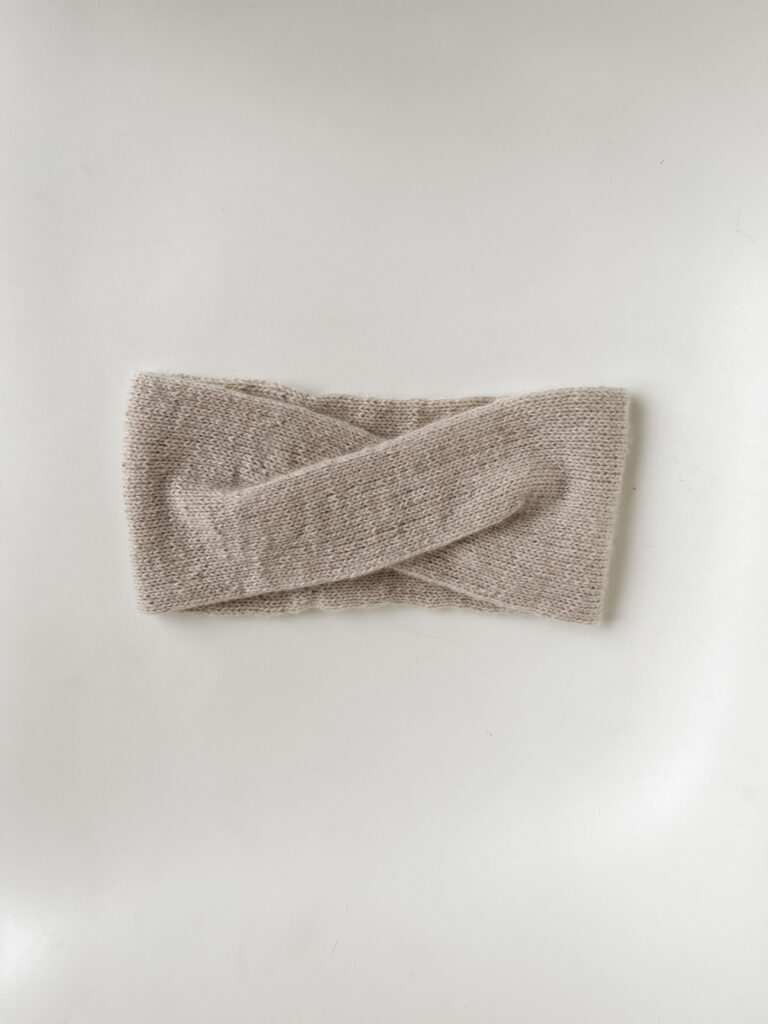
Instructions
- Cast on 40 stitches directly onto your circular needles using the method of your choice (e.g., long tail cast on).
- Join in the round. Pinch the cast-on row together to form a circle and knit the first stitch to connect to the last cast-on stitch. Now you can knit continuously around and around.
- Knit in the round. Knit every stitch on every round until your headband reaches your desired width. A good starting width is approximately 4 inches (10 cm).
- Decrease for shaping (optional). If you want a headband that fits more snugly around your ears, you can gradually decrease the number of stitches towards the end.
- Bind off. Once you’ve reached the desired length and completed any optional shaping, bind off all remaining stitches using your preferred method.
- Weave in ends. Use your tapestry needle to weave in the yarn tails for a neat finish.
Tips
- Try using a variegated or self-striping yarn to create a fun and colorful headband without having to change colors yourself.
- You can add a simple button closure to the back of your headband for adjustability.
4. Washcloth - Easy
Knitting washcloths is a practical and rewarding project for beginners. They’re not too big, quick to make, and allow you to experiment with different stitch patterns if you’re feeling adventurous.
Materials
- Cotton yarn (around 100 yards) suitable for dishcloths (look for dishcloth cotton or cotton blend yarn)
- Size US 7 (4.5 mm) knitting needles
- Tapestry needle
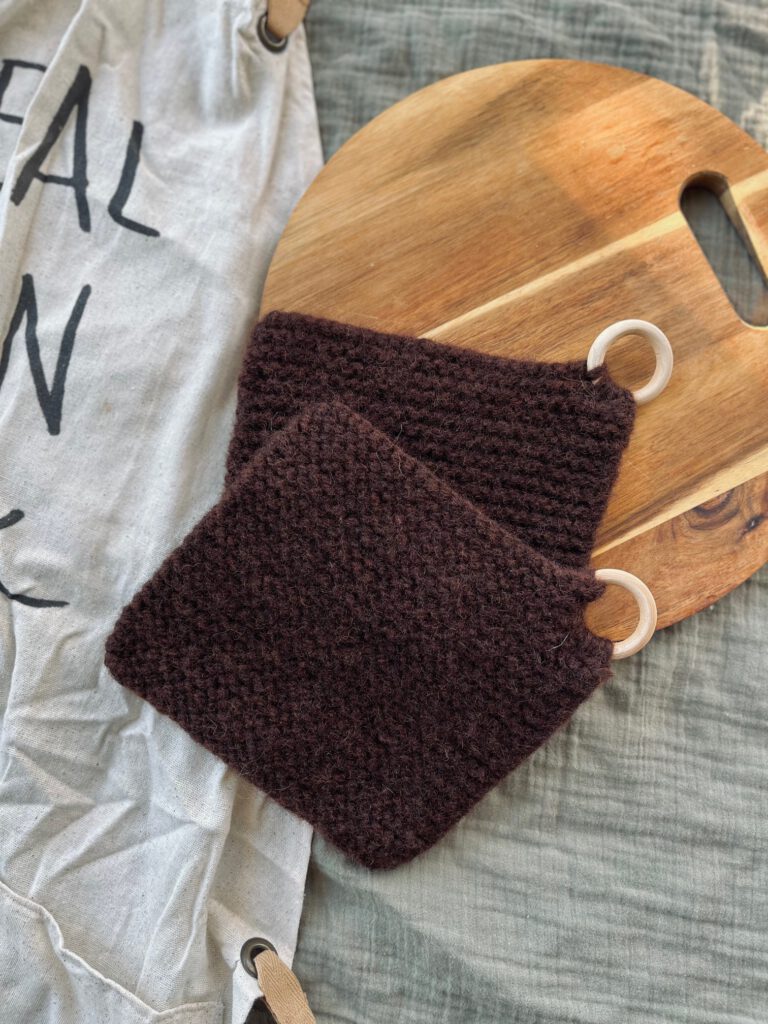
Instructions
- Cast on 40 stitches.
- Knit Garter Stitch Pattern (optional). This is a simple pattern where you knit every row. For a bit more texture, you can try alternating knit and purl rows.
- Continue knitting your chosen pattern until your washcloth reaches your desired size. A good starting size is approximately 8 inches (20 cm) square.
- Bind off.
- Weave in ends.
Tips
Cotton yarn is a good choice for washcloths because it’s absorbent and dries quickly.
5. Tote bag - Beginner Intermediate
A tote bag is a step up in complexity from the previous projects but is still achievable for intermediate beginners. It introduces basic shaping techniques like increasing and decreasing stitches.
Materials
- Worsted weight yarn (around 200-300 yards) in a color of your choice
- Size US 8 (5.0 mm) knitting needles (at least 32 inches or 80 cm long)
- Tapestry needle
- Stitch markers (optional)
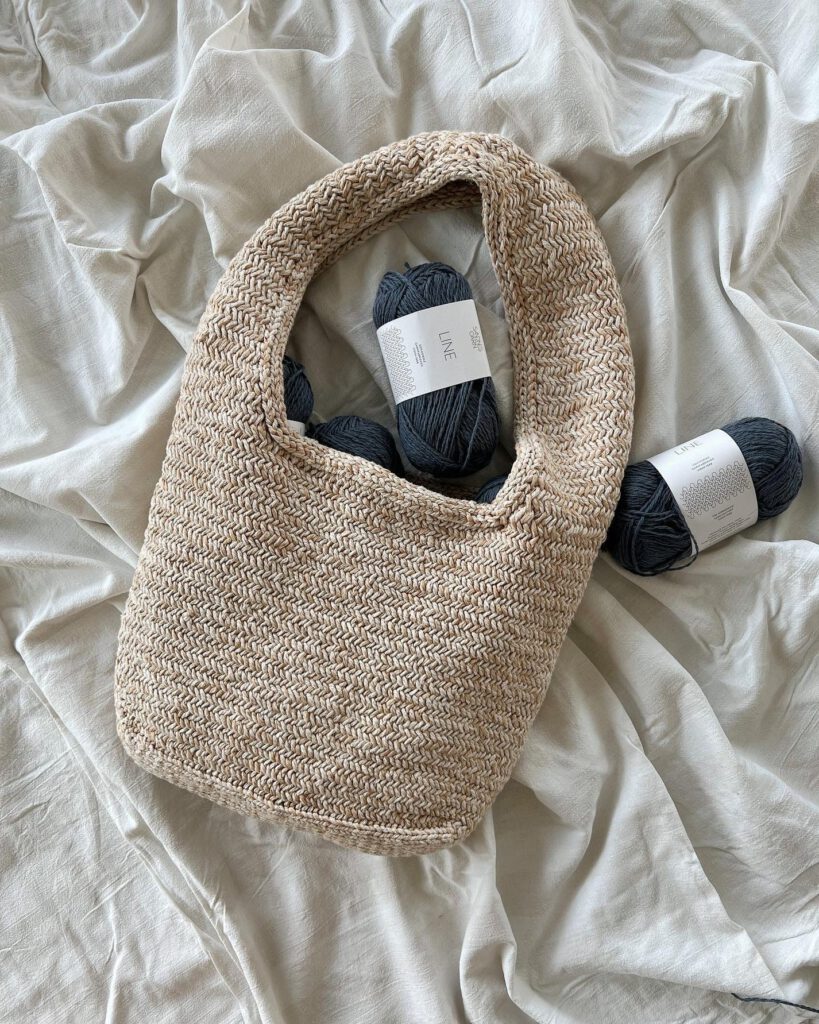
Instructions
- Cast on 40 stitches.
- Knit Garter Stitch Pattern (optional). Similar to the washcloth, you can choose to knit every row in a garter stitch for simplicity. However, for a bit more texture, you can explore other beginner-friendly stitch patterns like stockinette stitch or seed stitch.
- Work straight up for the bag body. Knit until your piece reaches approximately 12 inches (30 cm) in height.
- Shaping the gusset (optional): A gusset creates a triangular section at the bottom of the bag, allowing it to expand and hold more items.
- Increase for gusset (optional). Here’s where things get a little more intricate. There are various ways to increase stitches for a gusset. A beginner-friendly method is to make one stitch before the last stitch on every other row for a few rows (around 4-6 rows). This will gradually add stitches to your project.
- Continue knitting straight up. After adding the gusset stitches (if you choose to do so), knit for another 6-8 inches (15-20 cm) to create the height of the bag.
- Shaping the top (optional): You can create a simple straight top or add a gradual decrease for a more tapered look.
- Decrease for a tapered top (optional). Similar to increasing, there are different ways to decrease stitches. A beginner-friendly method is to knit two stitches together before the last stitch on every other row for a few rows (around 4-6 rows). This will gradually decrease the number of stitches.
- Bind off all remaining stitches.
Finishing Touches
- Handle straps (optional). You can create separate knitted straps or crochet straps using basic crochet techniques.
- Weave in ends. Use your tapestry needle to weave in all yarn tails for a neat finish.
Tips
- Consider using stitch markers to help you keep track of where to increase or decrease for the gusset and top shaping (optional).
- This project is a great opportunity to experiment with stripes or colorwork (using two or more colors) by introducing color changes throughout the knitting process.
6. Scarf - Easy
A scarf is a timeless and practical project, perfect for beginners. It allows you to practice basic knit stitches while creating a cozy and stylish accessory.
Materials
- Worsted weight yarn (around 100-200 yards, depending on the desired length) in a color of your choice
- Size US 8 (5.0 mm) knitting needles (at least 32 inches or 80 cm long)
- Tapestry needle
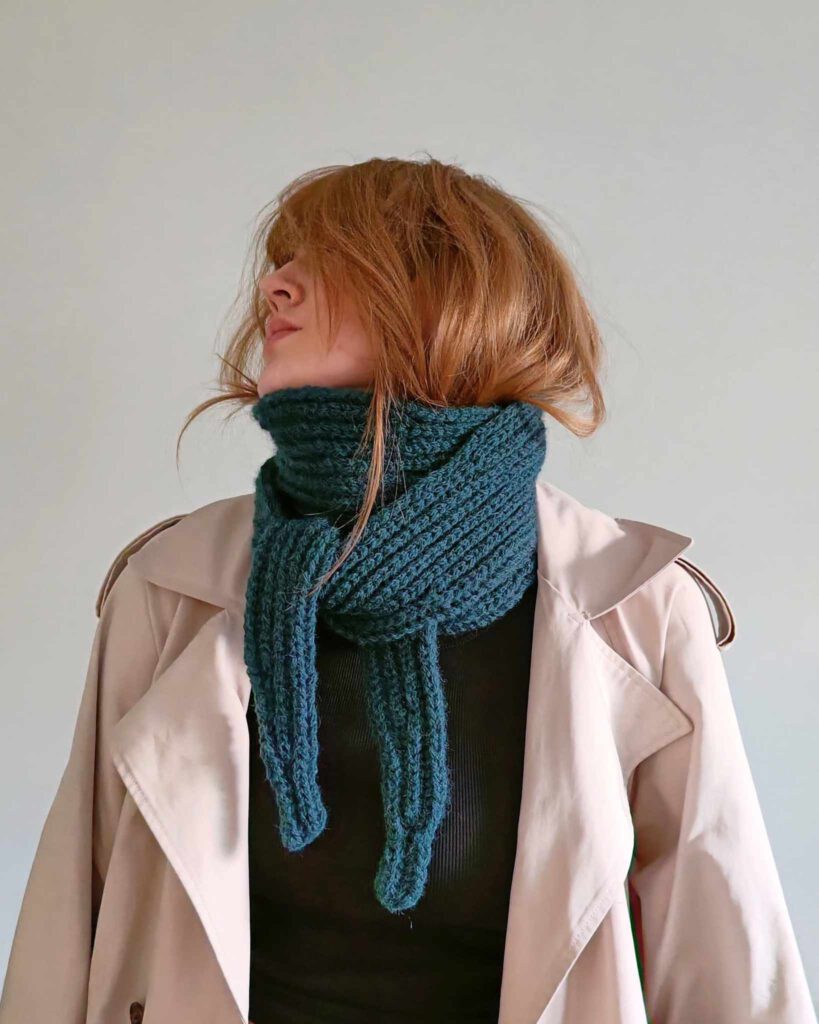
Instructions
- Cast on the desired number of stitches. A good starting point for a scarf is around 30-40 stitches. The more stitches you cast on, the wider your scarf will be.
- Knit every row. Continue knitting every stitch on every row until your scarf reaches your desired length. A typical scarf length is around 6 feet (1.8 meters), but you can adjust this to your preference.
- Bind off.
- Weave in ends.
Tips
- Consider using a variegated or self-striping yarn to create a visually interesting scarf without having to change colors yourself.
- You can add a simple fringe to the ends of your scarf for a decorative touch.
- This project is a great base for exploring different stitch patterns once you’re comfortable with the knit stitch. Many beginner-friendly stitch patterns can be easily incorporated into a scarf project.
Tips! We have a popular recipe for a scarf in our app. The scandi scarf is a great start to your knitting journey. Find the scarf here!
Additional tips to consider to make your first knitting project as easy as possible
Rely on a pattern
Look for patterns that spell out yarn requirements. Calculating yarn for a simple scarf might be a breeze, but for more complex projects, having clear instructions eliminates unnecessary stress. A good pattern will tell you exactly how much yarn you need for each color, taking the guesswork out of the equation. In the Knit&Note App, you can discover different features and heaps of fun and easy knitting patterns that are perfect for beginner projects.
How complex should knitting projects for beginners be?
Take a peek under the hood. If a pattern throws more than 3 unfamiliar techniques your way, consider starting with something a little simpler. Challenge is great, but pushing yourself too hard right off the bat can lead to frustration, especially for your first knitting projects. Remember, you’re building a foundation here, and small victories pave the way for bigger ones.
Start small, dream big
We all dream of crafting that stunning sweater someday. But try to hold your horses a little bit. Starting with an overly complex project can lead to discouragement. Instead, opt for a project with a shorter completion time – a cozy scarf, a cute headband, or a pair of washcloths. Quick wins will keep you motivated and excited to tackle bigger projects later!
Embrace the learning curve
Remember, knitting is a joyful journey, but like any skill, it takes time and practice. Those first projects might not be masterpieces, but view them as valuable training grounds. Your muscles and mind are working together to master new techniques, and with each stitch, you’re building the foundation for incredible creativity. So, be patient, embrace the learning process, and enjoy the magic of creating something beautiful with your own two hands.
In conclusion: What are the easiest things to knit for beginners?
Small but practical projects
There’s no single “easiest” thing to knit for beginners, as it can depend on your interests and no size fits all. However, some fantastic knitting projects for beginners offer quick wins and build essential skills. For instant results and a feeling of accomplishment in a short period, coasters and washcloths are perfect. They’re small, letting you practice knit stitches while creating something functional. Washcloths can even be a canvas for different stitch patterns if you’re feeling adventurous!
Cute accessories that come in handy
Headbands and scarves are cozy classics that refine your skills. Headbands introduce working “in the round,” a key technique for many projects. Scarves offer endless customization in size, color, and stitch patterns, so you can personalize them perfectly. Ready for a little more challenge? Tote bags introduce shaping techniques like increasing and decreasing stitches. While a step up from scarves, they’re still achievable for intermediate beginners.
The best project for you is the one that sparks your excitement! Explore patterns in our app or visit your local yarn store for inspiration. Remember, knitting is a journey, so embrace the learning process and enjoy creating something beautiful with your own hands!
Find more easy knitting projects for beginners in our app
Are you falling in love with knitting and your new skills? Our app has tons of fun and easy projects to keep you going, get inspired, and keep evolving. We’ve got patterns for everything from scarves and hats to cozy blankets. Plus, the app has clear instructions, and helpful tutorials, and even lets you share your projects with others. It’s like having your personal knitting coach in your pocket! Download the Knit&Note app today and see what amazing things you can create next.


